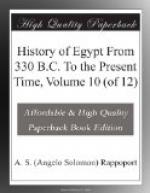[Illustration: 362.jpg Cleopatra’s needle.]
Taste, genius, and poetry had passed away; but mathematics, surgery, and grammar still graced the museum. The decline of art is shown upon the coins, and even in the shape of the letters upon the coins. On those of Cleopatra the engraver followed the fashion of the penman; the S is written like our C, the E has a round back, and the long O is formed like an M reversed.
During the reigns of the later Ptolemies the kingdom was under the shield, but also under the sceptre of Rome. Its kings sent to Rome for help, sometimes against their enemies, and sometimes against their subjects; sometimes they humbly asked the senate for advice, and at other times were able respectfully to disobey the Roman orders. One by one the senate seized the provinces; Coele-Syria, the coast of Asia Minor, Cyrene, and the island of Cyprus; and lastly, though the Ptolemies still reigned, they were counted among the clients of the Roman patrician, to whom they looked up for patronage. From this low state Egypt could scarcely be said to fall when it became a part of the great empire of Augustus.
During the reigns of the Ptolemies, the sculpture, the style of building, the religion, the writing, and the language of the Kopts in the Thebaid were nearly the same as when their own kings were reigning in Thebes, with even fewer changes than usually creep in through time. They had all become less simple; and though it would be difficult, and would want a volume by itself to trace these changes, and to show when they came into use, yet a few of them may be pointed out. The change of fashion must needs be slower in buildings which are only raised by the untiring labour of years, and which when built stand for ages; but in the later temples we find less strength as fortresses, few obelisks or sphinxes, and no colossal statues; we no longer meet with vast caves or pyramids. The columns in a temple have several new patterns. The capitals which used to be copied from the papyrus plant are now formed of lotus flowers, or palm branches. In some cases, with a sad want of taste, the weight of the roof rests on the weak head of a woman. The buildings, however, of the Ptolemies are such that, before the hieroglyphics on them had been read by Doctor Young, nobody had ever guessed that they were later than the time of Cambyses, while three or four pillars at Alexandria were almost the only proof that the country had ever been held by Greeks.
In the religion we find many new gods or old gods in new dresses. Hapimou, the Nile, now pours water out of a jar like a Greek river god. The moon, which before ornamented the heads of gods, is now a goddess under the name of Ioh. The favourite Isis had appeared in so many characters that she is called the goddess with ten thousand names.
[Illustration: 364.jpg GRAECO-EGYPTIAN COLUMN]




